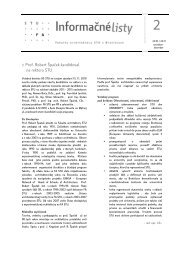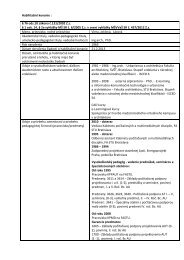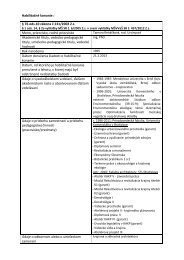ALFA 3-4/2005 - Fakulta architektúry STU
ALFA 3-4/2005 - Fakulta architektúry STU
ALFA 3-4/2005 - Fakulta architektúry STU
You also want an ePaper? Increase the reach of your titles
YUMPU automatically turns print PDFs into web optimized ePapers that Google loves.
Ročník 9<br />
3-4 / <strong>2005</strong> ARCHITEKTONICKÉ LISTY FA <strong>STU</strong><br />
they are ill, but also because they have been taken away from<br />
their familiar environment of their homes and placed in an<br />
institutional setting.<br />
Senses and perceptions<br />
We perceive our environment through our five senses: sight,<br />
smell, touch, taste and hearing. Our sensory system is<br />
constantly at work registering our surroundings. All of our senses<br />
sweep the world around us, providing the brain with information at<br />
an unperceivable rate. At a basic level, we are unconsciously<br />
registering our environment’s effects on our nervous system. All<br />
stimulus like heat, light, smell, noise, touch are continually<br />
supplied to the brain via our sensory systems so we can<br />
“experience” spaces. These experiences are combined with past<br />
memories to create perceptions. The information we pick up from<br />
our senses is relayed to the brain which, in turn, will affect our<br />
physiological, emotional, psychological and, ultimately, physical<br />
condition. Understanding the senses is the key to good design.<br />
It allows designers to create better responsive healing<br />
environments.<br />
Sight<br />
Our physical environment can have a huge effect on the way we<br />
feel. Natural light, pleasant views, works of art and particular<br />
colours can all enhance our sense of well-being. Light and colour<br />
are the two aspects of sight that have great impact on a patient’s<br />
overall well-being.<br />
Light: The therapeutic value of light has been ecognised for<br />
thousands of years. The Assyrians, Babylonians, Egyptians,<br />
Romans and Victorians all understood the healing properties of<br />
light. The effect of light on health is critical. Long ago hospitals had<br />
large windows that allowed light to penetrate deep plans.<br />
Solariums were used as healing environments. Essentially, we<br />
require for light. Light is life. With little or no natural light, melatonin<br />
(all-natural nightcap helps our bodies regulate our sleep-wake<br />
cycles) tells the body to log off, and even causes illnesses such as<br />
seasonal affective disorder.<br />
How can we bring light into our buildings? We can introduce more<br />
windows by rreducing mechanical and electrical interstitial space.<br />
We can manufacture it. We can even control its colour and<br />
intensity to influence our behaviour. The quality of natural or<br />
artificial light has a major impact on the body’s healing processes.<br />
Careful attention to this factor alone may help to reduce length of<br />
stay for inpatients. Other benefits of full spectrum lighting include:<br />
- Better visual perceptiveness<br />
- Improved body’s motor skills<br />
- Less physiological fatigue<br />
- Overall improved tasks performance.<br />
Particular attention should be paid to the lighting at the bed head<br />
and in patient examination, treatment and recovery areas.<br />
- 35 -<br />
Designers should develop high quality lighting schemes in public<br />
and ward areas that create a harmless and relaxing environment.<br />
They should also avoid equally spaced light fittings along corridors<br />
and hospital streets, as this may have a stroboscopic effect on<br />
patients moving along a corridor on a trolley sor in a bed.<br />
A reflected, diffused light is a better option. Lights should not be<br />
installed on ceilings immediately above patients in incubators,<br />
cots, beds, trolleys or couches. Lights should be designed to<br />
reflect off walls and ceilings. Where appropriate lighting should be<br />
dimmer controlled. Indirect lighting should be used extensively.<br />
Colour: Colour is an extremely powerful, and potentially<br />
inexpensive, medium. Appropriate use of colour within healthcare<br />
settings can make a significant contribution to patients’ well being<br />
and can evoke certain reactions or influence people’s moods.<br />
Certain colours slow one’s perception of time and others<br />
accelerate it. Our reactions to colours are led by a combination of<br />
biological, physiological, social and cultural factors. When it<br />
comes to emotions, there are differences between warm colours<br />
such as reds, oranges and yellows, and cold colours such as<br />
blues and violets.<br />
Reds and oranges, for example, are high-energy colours used by<br />
fast-food franchises in their restaurant interiors. Both hues<br />
stimulate digestion and sometimes cause restlessness, which is<br />
fine for fast-food restaurants, where quick client turnaround is<br />
desired. They are not the colours to use in sickroom settings,<br />
however, because they have been proven to raise blood pressure,<br />
quicken the pulse and increase breathing rates. Softer oranges<br />
and reds, such as peach or apricot hues, are more appropriate for<br />
restoring spent energy to body and mind without overstimulating.<br />
Vibrant burnt oranges and rust colours retain the influence of<br />
orange but temper it with the stability of brown, which ymbolizes<br />
reliability.<br />
The use of blue as a therapeutic colour is widely known. It’s<br />
calming and promotes physical and mental relaxation, stimulates<br />
healing and creativity, relieves pain and lowers blood pressure.<br />
This is why health care settings feature lighter shades of blue in<br />
their decor. Dark blue, on the other hand, has a sedative effect,<br />
and can make some people feel melancholic and dejected. So<br />
while it can be successfully employed in bedrooms to encourage<br />
sleep, it may be wise to use it sparingly in other areas.<br />
Mint green seems to pop up in hospital settings primarily because<br />
it’s proven to be calming and comfortable to look at, perhaps<br />
because people associate green with nature. Some researchers<br />
believe green can help balance physiological functions of heart,<br />
lungs and blood circulation. Natural shades of green, such as<br />
apple green, or olive green, are often used to add a serene look.<br />
While health is often improved using natural sunlight or light<br />
therapy, light colours don't always make us feel good. For<br />
example, a pure lemon yellow is a very cheerful colour and is an<br />
excellent choice for decorating areas where creativity is<br />
encouraged. It's important to balance an energetic yellow with

















